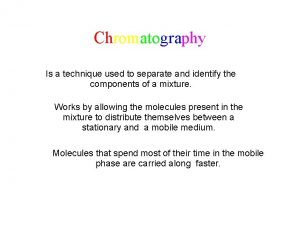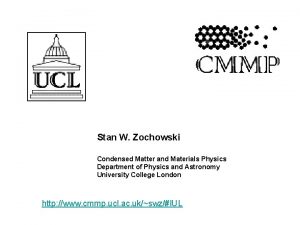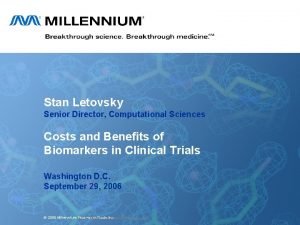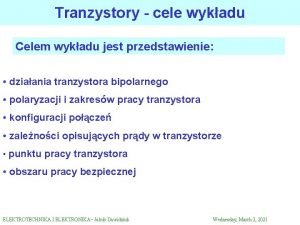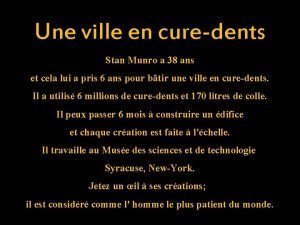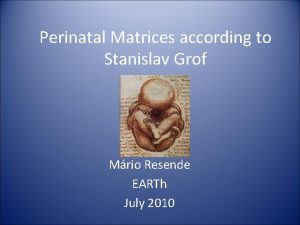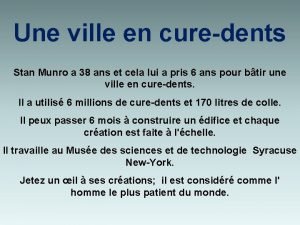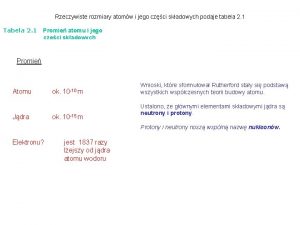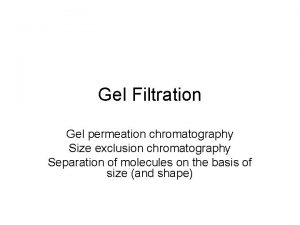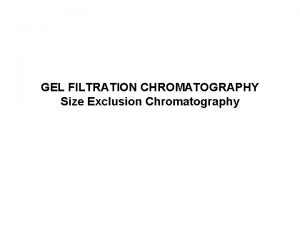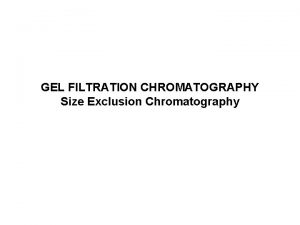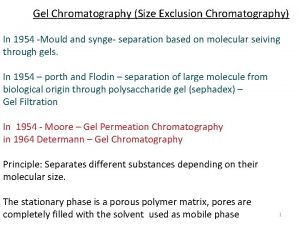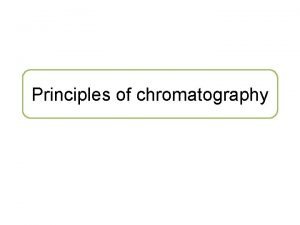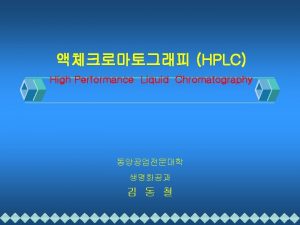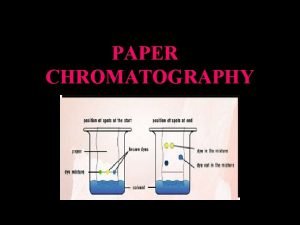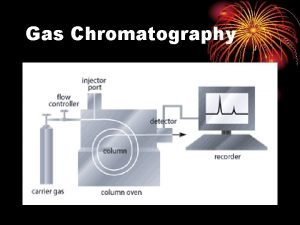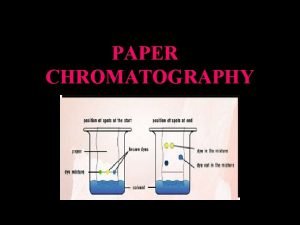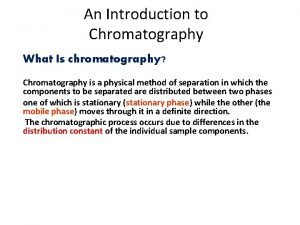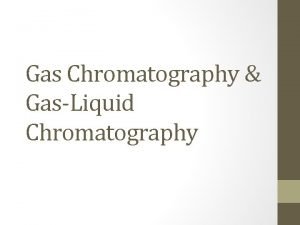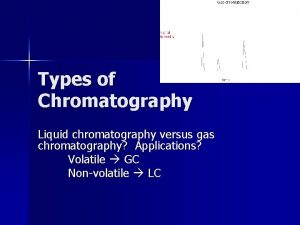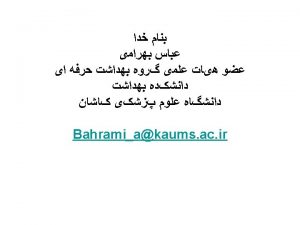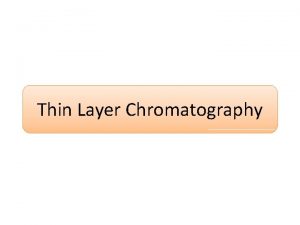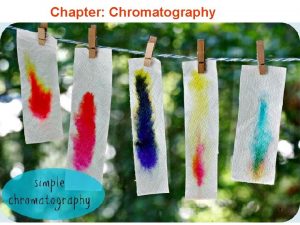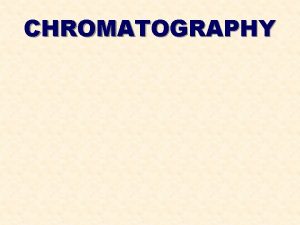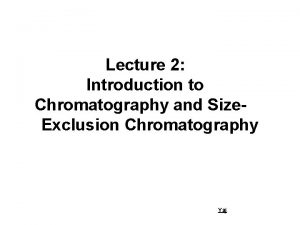Size Exclusion Chromatography Size Exclusion Chromatography Instructors Stan

























- Slides: 25


Size Exclusion Chromatography

Size Exclusion Chromatography Instructors Stan Hitomi Coordinator – Math & Science Principal – Alamo School San Ramon Valley Unified School District Danville, CA Kirk Brown Lead Instructor, Edward Teller Education Center Science Chair, Tracy High School and Delta College, Tracy, CA Bio-Rad Curriculum and Training Specialists: Sherri Andrews, Ph. D. sherri_andrews@bio-rad. com Essy Levy, M. Sc. essy_levy@bio-rad. com Leigh Brown, M. A. leigh_brown@bio-rad. com

Why Teach Size Exclusion Chromatography? • Powerful teaching tool • Laboratory extensions • Real-world connections • Link to careers and industry • Standards based


Size Exclusion Chromatography Kit Advantages • Standards Based • Can be used in Biology, Chemistry, or Physical Science • Sufficient materials for 8 student work stations • Easy preparation • Easy visualization of separation • Can be completed in one 45 minute lab session • Study how the structure and biochemical properties of molecules are related to their separation

Workshop Time Line • Introduction • Comparison of different types of column chromatography • Separation of a mixture of biomolecules by size exclusion chromatography 9/17/2020

Types of Column Chromatography • Affinity • Hydrophobic Interaction (HIC) • Ion Exchange – Anion – Cation • Gel Filtration or Size Exclusion (SEC) 9/17/2020

Affinity Chromatography • Uses an affinity tag - allows molecules to bind to the column - specific to the tagged protein of interest - Examples: HIS-Tag, antibody, GST-Tag • Proteins not bound pass through the column • A buffer is used to elute the protein from the column 9/17/2020 http: //tainano. com/Molecular%20 Biology%20 Glossary. files/image 047. gif

Ion Exchange Chromatography • Beads in the column are charged Anion - positively (+) charged beads Cation- negatively (-) charged beads • Molecule to be purified will have the opposite charge from the beads in the column • Molecules not binding to the beads pass through the column • A counter-charged buffer is used to elute the molecule of interest http: //tainano. com/Molecular%20 Biology%20 Glossary. files/image 047. gif

Hydrophobic Interaction Chromatography HIC • Beads in the column are hydrophobic • Column is treated with a high salt buffer • Hydrophobic proteins bind to the beads • A lower salt buffer elutes less hydrophobic proteins • A no salt buffer elutes the protein of interest

Size Exclusion Chromatography • Beads in column are made of polyacrylamide and have tiny pores • The mixture of molecules is added to the column • Large molecules move through the column quickly traveling around the beads • Smaller molecules move through the pores of the beads and take longer to pass through the column http: //tainano. com/Molecular%20 Biology%20 Glossary. files/image 047. gif

Principles of Size Exclusion Chromatography • The mass of beads in the column is called the column bed • Beads trap or sieve and filter molecules based on size • The separation of molecules is called fractionation • Size of pores in beads determines the exclusion limit (what goes through the beads and what goes around the beads) • Molecules are dissolved in a buffer

Principles of Size Exclusion Chromatography

Size Exclusion Chromatography Procedures Overview

Workstations Student Workstation Items Collection Tubes Column end-caps Pipet Lab Marker Test tube rack Number 12 1 1 1 Common Workstation Hemoglobin/Vitamin B mixture Column Buffer

Laboratory Quick Guide

Step 1: Label collection tubes • Label 10 collection tubes sequentially Step 2: Column Buffer • Aliquot 4 ml of Column buffer into the tube labeled column buffer • Label last 2 tubes “waste” and “column buffer”

Step 3: Prepare the Column • Remove the cap and snap off the end of the sizing column • Allow all of the buffer to drain into the waste tube • Cap the end of the column

Step 4: Add the protein mix to the column • Place column in tube 1 • Add 1 drop of protein mix

Step 5: Add column buffer and collect fractions • Carefully add 250 ml of column buffer to the top of the column (2 x) and begin to collect drops into tube 1 - Size separation will work best when the column is left undisturbed • Carefully add 3 ml of column buffer to the column • Transfer column to tube 2 and begin fraction collection • Collect 5 drops of buffer into tube 2 and transfer the column to tube 3 • Repeat the same collection procedure collecting 5 drops into each tube • Collect 10 drops at tube 10

Molecules of interest: Hemoglobin and Vitamin B 12 • Hemoglobin is brown and has a molecular weight of 65, 000 daltons • Vitamin B 12 is pink and has a mass of 1, 350 daltons • The exclusion limit of the beads is 60, 000 daltons: Hemoglobin will exit the column first, then Vitamin B 12

Hemoglobin (Hb) • Metalloprotein • Transports oxygen to the body • Found in the red blood cells (RBC) • Heme group contains an iron atom which is responsible oxygen binding • Sickle Cell Anemia rises from a point mutation http: //www. pdb. org DNA: Protein: Normal Cell Sickle Cell CCT GAG CCT GTG GAG Glu Val www. nhlbi. nih. gov

Vitamin B 12 • Important for normal functioning of the brain and nervous system • Involved in the metabolism of every cell in the body fatty acid synthesis and energy production DNA synthesis and regulation • Cyanocobalamin Cobalt (Co) central metal ion • Synthesized in bacteria • Coenzyme MUT: (Methylmalonyl-Co. A mutase) http: //history. nih. gov catalyzes the isomerization of methylmalonyl-Co. A to succinyl-Co. A, a key molecule of the TCS Cycle MTR: methyl transfer enzyme (5 -Methyltetrahydrofolate-homocysteine methyltransferase) catalyzes the conversion homocysteine into methionine, an essential amino acid

Webinars • Enzyme Kinetics — A Biofuels Case Study • Real-Time PCR — What You Need To Know and Why You Should Teach It! • Proteins — Where DNA Takes on Form and Function • From plants to sequence: a six week college biology lab course • From singleplex to multiplex: making the most out of your realtime experiments explorer. bio-rad. com Support Webinars
 Application of size exclusion chromatography
Application of size exclusion chromatography Principle of size exclusion chromatography
Principle of size exclusion chromatography Size exclusion chromatography animation
Size exclusion chromatography animation Edgar dale’s cone of experience?
Edgar dale’s cone of experience? Stan islande
Stan islande Canvas csustan
Canvas csustan Stan zochowski
Stan zochowski Stan letovsky
Stan letovsky Stan woody
Stan woody Brian fawcett
Brian fawcett Tranzystor bipolarny stany pracy
Tranzystor bipolarny stany pracy Stan shebs
Stan shebs Stan posey
Stan posey Stan munro
Stan munro Grof perinatal matrices
Grof perinatal matrices Stan munro
Stan munro Deep stan tool
Deep stan tool Stan owocki
Stan owocki Stan opella
Stan opella Pravidelný čtyřboký jehlan vzorce
Pravidelný čtyřboký jehlan vzorce Zapełnianie powłok elektronowych
Zapełnianie powłok elektronowych Dave lawton
Dave lawton Santa clara county
Santa clara county Stan graniczny nośności
Stan graniczny nośności Epr warszawa
Epr warszawa Matrix multiplication stan
Matrix multiplication stan


